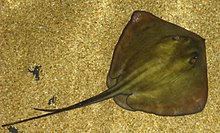Sting Ray
| Stingrays Temporal range: Early Cretaceous–Recent |
|
|---|---|
 |
|
| Common stingray (Dasyatis pastinaca) | |
| Scientific classification | |
| Kingdom: | Animalia |
| Phylum: | Chordata |
| Class: | Chondrichthyes |
| Order: | Myliobatiformes |
| Suborder: | Myliobatoidei |
| Families | |
Stingrays are a group of rays, which are cartilaginous fish related to sharks. They are classified in the suborder Myliobatoidei of the order Myliobatiformes and consist of eight families: Hexatrygonidae (sixgill stingray), Plesiobatidae (deepwater stingray), Urolophidae (stingarees), Urotrygonidae (round rays), Dasyatidae (whiptail stingrays), Potamotrygonidae (river stingrays), Gymnuridae (butterfly rays), and Myliobatidae (eagle rays).
Most stingrays have one or more barbed stingers (modified from dermal denticles) on the tail, which are used exclusively in self-defense. The stinger may reach a length around 35 cm (14 in), and its underside has two grooves with venom glands. The stinger is covered with a thin layer of skin, the integumentary sheath, in which the venom is concentrated. A few members of the suborder, such as the manta and porcupine rays, do not have stingers.
Stingrays are common in coastal tropical and subtropical marine waters throughout the world. Some species, such as Dasyatis thetidis, are found in warmer temperate oceans, and others, such as Plesiobatis daviesi, are found in the deep ocean. The river stingrays, and a number of whiptail stingrays (such as the Niger stingray), are restricted to fresh water. Most myliobatoids are demersal (inhabiting the next-to-lowest zone in the water column), but some, such as the pelagic stingray and the eagle rays, are pelagic.
...
Wikipedia
